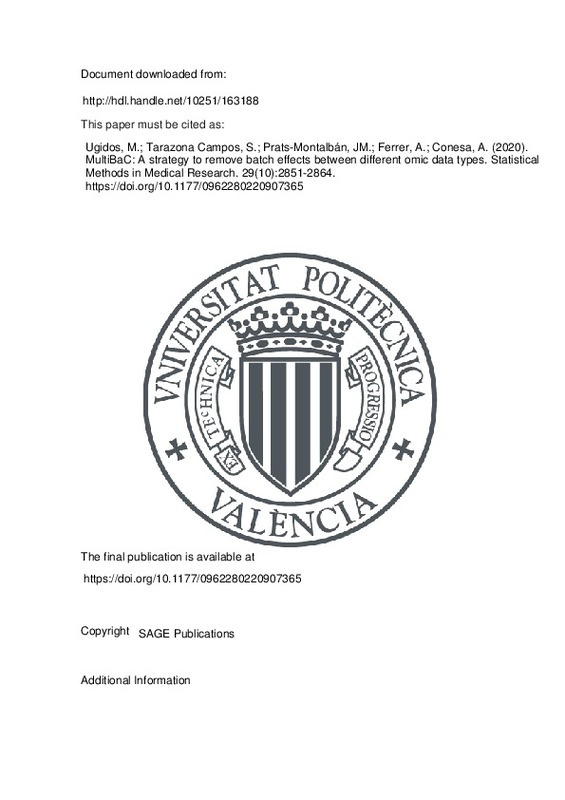Kupfer, P., Guthke, R., Pohlers, D., Huber, R., Koczan, D., & Kinne, R. W. (2012). Batch correction of microarray data substantially improves the identification of genes differentially expressed in Rheumatoid Arthritis and Osteoarthritis. BMC Medical Genomics, 5(1). doi:10.1186/1755-8794-5-23
Gregori, J., Villarreal, L., Méndez, O., Sánchez, A., Baselga, J., & Villanueva, J. (2012). Batch effects correction improves the sensitivity of significance tests in spectral counting-based comparative discovery proteomics. Journal of Proteomics, 75(13), 3938-3951. doi:10.1016/j.jprot.2012.05.005
Ritchie, M. E., Phipson, B., Wu, D., Hu, Y., Law, C. W., Shi, W., & Smyth, G. K. (2015). limma powers differential expression analyses for RNA-sequencing and microarray studies. Nucleic Acids Research, 43(7), e47-e47. doi:10.1093/nar/gkv007
[+]
Kupfer, P., Guthke, R., Pohlers, D., Huber, R., Koczan, D., & Kinne, R. W. (2012). Batch correction of microarray data substantially improves the identification of genes differentially expressed in Rheumatoid Arthritis and Osteoarthritis. BMC Medical Genomics, 5(1). doi:10.1186/1755-8794-5-23
Gregori, J., Villarreal, L., Méndez, O., Sánchez, A., Baselga, J., & Villanueva, J. (2012). Batch effects correction improves the sensitivity of significance tests in spectral counting-based comparative discovery proteomics. Journal of Proteomics, 75(13), 3938-3951. doi:10.1016/j.jprot.2012.05.005
Ritchie, M. E., Phipson, B., Wu, D., Hu, Y., Law, C. W., Shi, W., & Smyth, G. K. (2015). limma powers differential expression analyses for RNA-sequencing and microarray studies. Nucleic Acids Research, 43(7), e47-e47. doi:10.1093/nar/gkv007
Gagnon-Bartsch, J. A., & Speed, T. P. (2011). Using control genes to correct for unwanted variation in microarray data. Biostatistics, 13(3), 539-552. doi:10.1093/biostatistics/kxr034
Nueda, M. j., Ferrer, A., & Conesa, A. (2011). ARSyN: a method for the identification and removal of systematic noise in multifactorial time course microarray experiments. Biostatistics, 13(3), 553-566. doi:10.1093/biostatistics/kxr042
Jansen, J. J., Hoefsloot, H. C. J., van der Greef, J., Timmerman, M. E., Westerhuis, J. A., & Smilde, A. K. (2005). ASCA: analysis of multivariate data obtained from an experimental design. Journal of Chemometrics, 19(9), 469-481. doi:10.1002/cem.952
Nueda, M. J., Conesa, A., Westerhuis, J. A., Hoefsloot, H. C. J., Smilde, A. K., Talón, M., & Ferrer, A. (2007). Discovering gene expression patterns in time course microarray experiments by ANOVA–SCA. Bioinformatics, 23(14), 1792-1800. doi:10.1093/bioinformatics/btm251
Giordan, M. (2013). A Two-Stage Procedure for the Removal of Batch Effects in Microarray Studies. Statistics in Biosciences, 6(1), 73-84. doi:10.1007/s12561-013-9081-1
Nyamundanda, G., Poudel, P., Patil, Y., & Sadanandam, A. (2017). A Novel Statistical Method to Diagnose, Quantify and Correct Batch Effects in Genomic Studies. Scientific Reports, 7(1). doi:10.1038/s41598-017-11110-6
Reese, S. E., Archer, K. J., Therneau, T. M., Atkinson, E. J., Vachon, C. M., de Andrade, M., … Eckel-Passow, J. E. (2013). A new statistic for identifying batch effects in high-throughput genomic data that uses guided principal component analysis. Bioinformatics, 29(22), 2877-2883. doi:10.1093/bioinformatics/btt480
Papiez, A., Marczyk, M., Polanska, J., & Polanski, A. (2018). BatchI: Batch effect Identification in high-throughput screening data using a dynamic programming algorithm. Bioinformatics, 35(11), 1885-1892. doi:10.1093/bioinformatics/bty900
Keel, B. N., Zarek, C. M., Keele, J. W., Kuehn, L. A., Snelling, W. M., Oliver, W. T., … Lindholm-Perry, A. K. (2018). RNA-Seq Meta-analysis identifies genes in skeletal muscle associated with gain and intake across a multi-season study of crossbred beef steers. BMC Genomics, 19(1). doi:10.1186/s12864-018-4769-8
Li, M. D., Burns, T. C., Morgan, A. A., & Khatri, P. (2014). Integrated multi-cohort transcriptional meta-analysis of neurodegenerative diseases. Acta Neuropathologica Communications, 2(1). doi:10.1186/s40478-014-0093-y
Andres-Terre, M., McGuire, H. M., Pouliot, Y., Bongen, E., Sweeney, T. E., Tato, C. M., & Khatri, P. (2015). Integrated, Multi-cohort Analysis Identifies Conserved Transcriptional Signatures across Multiple Respiratory Viruses. Immunity, 43(6), 1199-1211. doi:10.1016/j.immuni.2015.11.003
Sandhu, V., Labori, K. J., Borgida, A., Lungu, I., Bartlett, J., Hafezi-Bakhtiari, S., … Haibe-Kains, B. (2019). Meta-Analysis of 1,200 Transcriptomic Profiles Identifies a Prognostic Model for Pancreatic Ductal Adenocarcinoma. JCO Clinical Cancer Informatics, (3), 1-16. doi:10.1200/cci.18.00102
Huang, H., Liu, C.-C., & Zhou, X. J. (2010). Bayesian approach to transforming public gene expression repositories into disease diagnosis databases. Proceedings of the National Academy of Sciences, 107(15), 6823-6828. doi:10.1073/pnas.0912043107
Pelechano, V., & Pérez-Ortín, J. E. (2010). There is a steady-state transcriptome in exponentially growing yeast cells. Yeast, 27(7), 413-422. doi:10.1002/yea.1768
Garcı́a-Martı́nez, J., Aranda, A., & Pérez-Ortı́n, J. E. (2004). Genomic Run-On Evaluates Transcription Rates for All Yeast Genes and Identifies Gene Regulatory Mechanisms. Molecular Cell, 15(2), 303-313. doi:10.1016/j.molcel.2004.06.004
Pelechano, V., Chávez, S., & Pérez-Ortín, J. E. (2010). A Complete Set of Nascent Transcription Rates for Yeast Genes. PLoS ONE, 5(11), e15442. doi:10.1371/journal.pone.0015442
Zid, B. M., & O’Shea, E. K. (2014). Promoter sequences direct cytoplasmic localization and translation of mRNAs during starvation in yeast. Nature, 514(7520), 117-121. doi:10.1038/nature13578
Freeberg, M. A., Han, T., Moresco, J. J., Kong, A., Yang, Y.-C., Lu, Z., … Kim, J. K. (2013). Pervasive and dynamic protein binding sites of the mRNA transcriptome in Saccharomyces cerevisiae. Genome Biology, 14(2), R13. doi:10.1186/gb-2013-14-2-r13
McKinlay, A., Araya, C. L., & Fields, S. (2011). Genome-Wide Analysis of Nascent Transcription in Saccharomyces cerevisiae. G3 Genes|Genomes|Genetics, 1(7), 549-558. doi:10.1534/g3.111.000810
Castells-Roca, L., García-Martínez, J., Moreno, J., Herrero, E., Bellí, G., & Pérez-Ortín, J. E. (2011). Heat Shock Response in Yeast Involves Changes in Both Transcription Rates and mRNA Stabilities. PLoS ONE, 6(2), e17272. doi:10.1371/journal.pone.0017272
Wold, S., Sjöström, M., & Eriksson, L. (2001). PLS-regression: a basic tool of chemometrics. Chemometrics and Intelligent Laboratory Systems, 58(2), 109-130. doi:10.1016/s0169-7439(01)00155-1
Folch-Fortuny, A., Vitale, R., de Noord, O. E., & Ferrer, A. (2017). Calibration transfer between NIR spectrometers: New proposals and a comparative study. Journal of Chemometrics, 31(3), e2874. doi:10.1002/cem.2874
García Muñoz, S., MacGregor, J. F., & Kourti, T. (2005). Product transfer between sites using Joint-Y PLS. Chemometrics and Intelligent Laboratory Systems, 79(1-2), 101-114. doi:10.1016/j.chemolab.2005.04.009
Andrade, J. M., Gómez-Carracedo, M. P., Krzanowski, W., & Kubista, M. (2004). Procrustes rotation in analytical chemistry, a tutorial. Chemometrics and Intelligent Laboratory Systems, 72(2), 123-132. doi:10.1016/j.chemolab.2004.01.007
Hurley, J. R., & Cattell, R. B. (2007). The procrustes program: Producing direct rotation to test a hypothesized factor structure. Behavioral Science, 7(2), 258-262. doi:10.1002/bs.3830070216
Hartigan, J. A., & Wong, M. A. (1979). Algorithm AS 136: A K-Means Clustering Algorithm. Applied Statistics, 28(1), 100. doi:10.2307/2346830
[-]







![[Cerrado]](/themes/UPV/images/candado.png)


